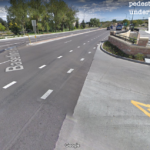Mission: To promote driving less so all may live more.
The previous post explained how the City of Boulder addressed the flashing crosswalk where Laura was hit by an SUV. In short, they addressed it gloriously:
(1) they upgraded to a light that first flashed, then turned solid yellow, and finally turned solid red (putting the fear of Officer MacDougal in drivers), and
(2) they later made the supreme fix: building an underpass
to completely insulate pedestrians and bikers from those big, heavy chunks of metal and plastic that accelerate more easily than they brake.

As I stated before, anything Boulder has learned in the past concerning pedestrian and bicyclist safety is probably a lesson some city is about to learn in the present, if it learns at all, making Boulder a good test case.
This short post covers two things:
(1) a few statistics from another The Daily Camera article, “Boulder’s most dangerous crosswalk getting $68,000 traffic light” (07/09/2010), which was written three years after Laura’s incident, announcing that the crosswalk would soon have a HAWK (the light that flashes, turns solid yellow, and finally turns solid red when activated), and
(2) a tweet along with some statistics that support the tweet (sometimes tweets need that).
“Boulder’s most dangerous crosswalk getting $68,000 traffic light” (07/09/2010)
Statistics
1 in 7—Number of vehicles that fail to yield to pedestrians in flashing crosswalks
127—Number of car vs. pedestrian accidents in Boulder from January 2008 to April 2010
378—Number of car vs. bike accidents in Boulder from January 2008 to April 2010
60 percent—Share of pedestrian or bike accidents that occur at crosswalks or intersections
On the Odds of Dying
Tweet
If you think no one should fly in Boeing 737 Max 8s because they’re too dangerous, wait until you hear about driving in cars.
— Bicycle Lobby (@BicycleLobby) March 12, 2019
Statistics
Without making light of the Boeing 737 Max 8s crashes, here are some statistics on dying-by-walking-or-biking:[1]
- Pedestrian deaths in 2015: 5,376
- Estimated pedestrian injuries in 2015: 70,000
- Bicyclist deaths in 2015: 818
- Estimated bicyclist injuries in 2015: 45,000
Sounds grim? Yes and no. What are the really common ways of dying?
According to the same source, “this number [of pedestrian deaths and injuries] dwarfs the 32,675 total deaths due to motor vehicle crashes and the relatively small 4,884 pedestrian deaths in 2014. In fact, the number of deaths in 2000 caused by poor diet and physical inactivity increased by approximately 66,000, accounting for about 15.2 percent of the total number of deaths” (emphasis mine).
The moral: we don’t die according to our fears but according to our confidences and comforts. Getting in a car sounds safe and eating fried chicken sounds comforting. They both keep the ER and the morticians busy. The difference, though, is that automobiles endanger everyone. I’d love to see all of us with better diets, but the neighbor eating poorly doesn’t endanger my life. The person hopping in the car does.
____Footnotes____
[1] Taken from The Pedestrian & Bicycle Information Center.
Next post is the “Person Meets Police,” a short post about my recent encounter with the Lafayette Police. It was non-adversarial… so don’t get your hopes up… I’m still at large on the streets.
